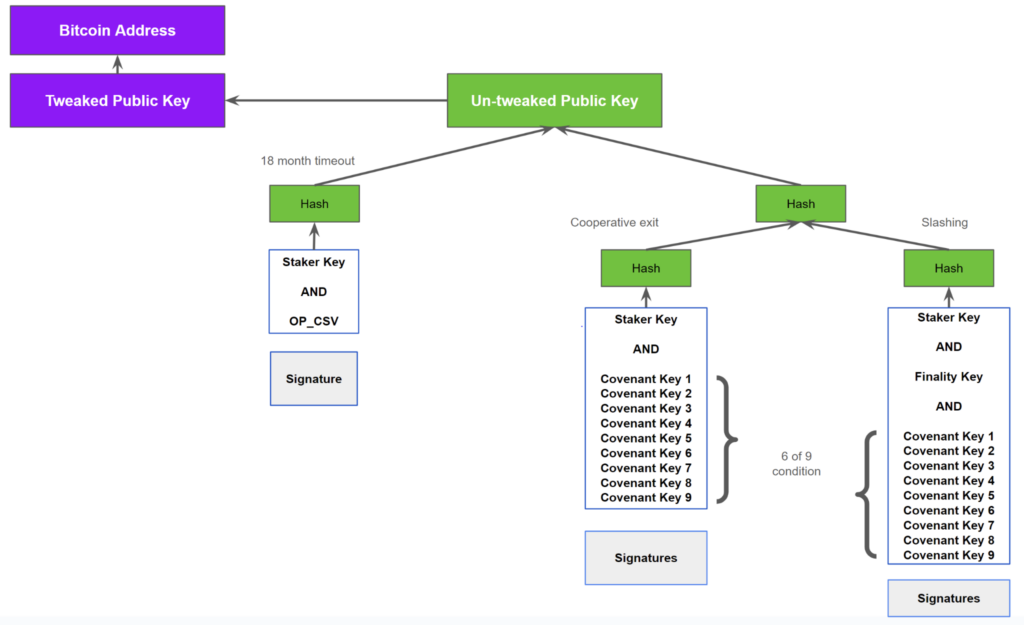What is Taproot in Bitcoin – Exploring the Future of Privacy and Efficiency
What is Taproot in Bitcoin? Taproot is a significant upgrade to the Bitcoin protocol that enhances privacy, scalability, and smart contracting capabilities. This transformative feature promises to bolster Bitcoin’s utility and provides users with an advanced level of transaction confidentiality.
Introduction to Taproot: Bitcoin’s Privacy and Efficiency Upgrade

Bitcoin has long been hailed as a revolutionary digital currency that empowers individuals to transact without relying on central authorities. However, as the network grew, so did the complexity of transactions and the need for enhanced privacy measures. Enter Taproot—a groundbreaking upgrade aimed at addressing these challenges while maintaining Bitcoin’s core principles.
Taproot is more than just a technical change; it represents a paradigm shift in how we think about privacy and efficiency within the Bitcoin ecosystem. By integrating innovative technologies like Schnorr signatures and Merkleized Abstract Syntax Trees (MAST), Taproot sets the stage for a future where complex transactions can be conducted with greater confidentiality and reduced blockchain bloat. The following sections delve deeper into the key components of Taproot, exploring how they work together to elevate Bitcoin’s functionality.
Understanding the Need for Taproot
The evolution of Bitcoin has been marked by a series of upgrades—each designed to address emerging challenges in security, scalability, and usability.
Bitcoins’ original structure allowed for straightforward peer-to-peer transactions, but as its adoption grew, so too did the number of participants and transaction types. The introduction of multi-signature wallets, time-locked contracts, and other intricate arrangements became commonplace. With these advancements, however, came a trade-off: increased complexity often leads to decreased privacy.
This is where Taproot enters the scene, providing a timely solution to the issues surrounding transaction privacy and efficiency. By enhancing the way transactions are recorded on the blockchain, Taproot aims to ensure that Bitcoin remains a viable option for users who value both discretion and ease of use.
The Role of Community in Taproot’s Development
One of the most compelling aspects of Bitcoin’s development is the collaborative nature of its community. Taproot was conceived through extensive discussions, research, and proposals put forth by numerous developers and enthusiasts passionate about improving Bitcoin.
The Bitcoin Improvement Proposal (BIP) 340 introduced Taproot to the community, laying out a comprehensive plan to enhance Bitcoin’s functionality. The proposal fostered an environment of transparency and collective effort, culminating in the successful activation of Taproot through a consensus-driven process known as “BIP 341.” This highlights not only the significance of community involvement but also the effectiveness of decentralized governance in propelling innovations.
Key Goals of Taproot
At its core, the goal of Taproot is threefold:
- Privacy Improvements – To obscure the details of complex transactions, making Bitcoin more appealing for everyday users.
- Enhancements to Smart Contracts – To allow for more sophisticated programming capabilities on the Bitcoin network.
- Increased Efficiency – To reduce the size of data stored on the blockchain, optimizing space and speeding up transaction verification.
Each of these goals intersects, creating a cohesive framework that positions Bitcoin for the future while honoring its foundational ethos.
Taproot’s Key Components: Schnorr Signatures and Merkleized Abstract Syntax Trees (MAST)

To understand what makes Taproot a game-changer, it’s essential to explore its fundamental components: Schnorr signatures and Merkleized Abstract Syntax Trees (MAST). These two technologies are vital in facilitating the upgrades that Taproot brings to the table.
Schnorr Signatures: The Basics
Schnorr signatures represent a novel approach to cryptographic signing, providing several advantages over the traditional ECDSA (Elliptic Curve Digital Signature Algorithm) used in Bitcoin.
Enhanced Security Features
Schnorr signatures are known for their security properties, which offer protection against certain vulnerabilities that exist within ECDSA. This robustness is crucial in an era where cybersecurity threats continue to evolve.
Aggregate Signatures
One of the standout features of Schnorr signatures is their ability to enable aggregation. This means that multiple signatures can be combined into a single signature. For example, in a multi-signature wallet scenario, rather than having separate signatures for each participant, Schnorr allows for a single aggregated signature. This results in a more streamlined transaction process and reduces the amount of data stored on the blockchain.
Signature Validation Process
The validation of Schnorr signatures is simplified compared to ECDSA, leading to faster verification times. This efficiency not only speeds up transactions but also contributes positively to the overall scalability of the Bitcoin network.
Merkleized Abstract Syntax Trees (MAST): Simplifying Complexity
MAST serves as the second cornerstone of Taproot, allowing for enhanced privacy and flexibility in smart contracts.
Structuring Complex Conditions
MAST enables the creation of complex Bitcoin scripts organized in a tree structure. Each leaf in the tree represents a possible spending condition, and the root of the tree condenses all this information. With MAST, only the executed conditions are revealed, preserving the privacy of alternative conditions that remain hidden.
Reduced On-Chain Data
By leveraging MAST, users can significantly decrease the amount of data that must be recorded on the Bitcoin blockchain. Only relevant data is exposed during a transaction, minimizing the burden on the network while simultaneously enriching user privacy.
Enhancing Smart Contract Capabilities
MAST opens the door to more sophisticated uses of Bitcoin, such as escrow and time-locked contracts, without compromising confidentiality. This paves the way for innovative applications and services built on the Bitcoin network, further solidifying its role in the cryptocurrency landscape.
How Taproot Enhances Bitcoin Privacy: Obscuring Complex Transactions

Privacy has always been a significant concern in the world of cryptocurrencies, and Taproot addresses this issue head-on. By combining Schnorr signatures with MAST, Taproot enables Bitcoin users to keep their transactions private—even when they involve complex smart contracts.
The Importance of Transaction Privacy
As Bitcoin continues to gain traction among mainstream users, ensuring transaction privacy becomes paramount. Public blockchains inherently expose transaction details to anyone viewing the chain. This visibility can deter users from adopting Bitcoin for fear of being tracked or identified.
With Taproot, hidden complexities in transactions act as a shield that protects user identities. The combination of Schnorr and MAST ensures that even if a user executes a complex contract, the underlying details remain obscured, making it far more challenging to analyze individual transactions.
Obscuring Multi-Signature Transactions
Multi-signature wallets have become increasingly popular as a means of securing Bitcoin holdings. However, under the current system, all signatures are visible on the blockchain.
With Taproot, the process changes dramatically. Instead of revealing every individual signature, the aggregated Schnorr signature conceals the number of signers involved in the transaction. This anonymity adds a layer of privacy that was previously unavailable, encouraging more users to adopt multi-signature solutions.
Keeping Alternative Conditions Private
One of the strongest benefits of using MAST is its ability to protect alternative conditions within smart contracts. When a contract involves multiple potential paths, conventional methods would disclose all possible conditions upon execution.
Taproot alters this dynamic by allowing only the executed condition to be revealed. As a result, observers on the blockchain cannot discern the full extent of the contract’s complexity, allowing users to retain control over their information and maintaining the integrity of their financial activities.
Improving Bitcoin Efficiency and Scalability with Taproot
Scalability remains one of Bitcoin’s most pressing challenges. As more users join the network and transaction volumes increase, the potential for congestion and delays grows. Taproot offers solutions that not only enhance efficiency but also contribute to the overall scalability of the network.
Reducing Blockchain Bloat
Every transaction on the Bitcoin blockchain consumes space, and with the rise of complex transactions, this consumption has led to increased data storage requirements.
Taproot mitigates this problem through its aggregation capabilities and MAST structure. By reducing the amount of data required for each transaction, Taproot lessens the load on the blockchain, ultimately leading to more efficient use of space. This reduction is critical in ensuring that Bitcoin can scale alongside its growing user base.
Faster Verification Times
As mentioned previously, Schnorr signatures streamline the signature verification process significantly. This improvement allows nodes to validate transactions more quickly, contributing to shorter confirmation times.
Faster verification promotes a smoother user experience as transactions can be processed promptly. This improvement can have a ripple effect on the entire ecosystem, fostering higher levels of adoption as users encounter fewer barriers to entry.
Enabling Layer 2 Solutions
The advent of Taproot will likely stimulate the growth of Layer 2 solutions, such as the Lightning Network. These additional layers provide opportunities for off-chain transactions, alleviating pressure on the main Bitcoin blockchain while still benefiting from its security protocols.
As Taproot simplifies transactions, it may incentivize developers to build more applications atop the Bitcoin network, thus increasing usage and drawing in new users eager to engage with innovative financial products.
Taproot Adoption and Activation: A Community-Driven Upgrade
The path to activating Taproot involved a collaborative effort that showcased the strength of the Bitcoin community. Despite differing opinions on various proposals, the activation process remained largely democratic and transparent.
The Journey from Proposal to Activation
Taproot began as a theoretical concept within the community, evolving into Bitcoin Improvement Proposals (BIPs) that outlined its technical specifics and implementation plans. The BIPs generated extensive discussion, workshops, and reviews among developers, miners, and users alike.
Consensus Mechanism
A notable aspect of Bitcoin’s governance model is its reliance on consensus. The Taproot upgrade required buy-in from significant stakeholders, including miners and node operators. Through a soft fork mechanism, participants voted on whether to accept the changes, demonstrating the importance of collective agreement in shaping the network’s future.
Celebrating Successful Activation
On November 14, 2021, the Taproot upgrade officially activated, marking a historic milestone for Bitcoin. The community celebrated not just the technical achievement but also the shared commitment to improving the network collaboratively. The event underscored the potential of decentralized governance and set a precedent for future upgrades.
The Future Implications of Taproot for Bitcoin Development
As Taproot continues to gain traction, its implications for the future of Bitcoin development are vast and promising. It serves as a foundation for a new era of innovation while reinforcing the principles that underpin the network.
Innovative Use Cases and Applications
With enhanced privacy and efficiency, Taproot paves the way for unique applications of Bitcoin technology. Developers can now explore more sophisticated smart contracts, enabling functionalities such as automated escrow services, decentralized finance (DeFi) applications, and more.
The integration of Taproot may lead to profound industry shifts as businesses and users discover novel ways to utilize Bitcoin beyond simple transactions.
Strengthening Bitcoin’s Position in the Crypto Space
As cryptocurrencies proliferate, competition continues to intensify. Taproot positions Bitcoin as a formidable contender, providing it with tools necessary to keep pace with newer platforms. This advancement may reassure existing users and attract newcomers seeking a robust and feature-rich cryptocurrency.
Encouraging Ongoing Upgrades
Finally, Taproot’s activation demonstrates the feasibility of progressive improvements within the Bitcoin network. The success of this upgrade may encourage ongoing development efforts, ensuring that Bitcoin remains adaptable in an ever-evolving digital landscape. Future upgrades could build on Taproot’s infrastructure, increasing functionality while preserving security and decentralization.
Conclusion
In conclusion, what is Taproot in Bitcoin? It is a transformative upgrade that combines innovative technologies like Schnorr signatures and MAST to enhance privacy, efficiency, and scalability within the Bitcoin network. By enabling complex transactions to remain private and reducing the on-chain footprint, Taproot positions Bitcoin for a prosperous future. The activation of Taproot signifies not only a technical achievement but also the power of community-driven development. As the cryptocurrency landscape continues to evolve, Taproot stands as a beacon of progress, inviting developers and users alike to unlock new possibilities within Bitcoin’s robust framework.
